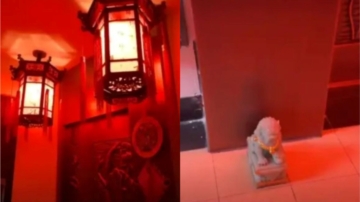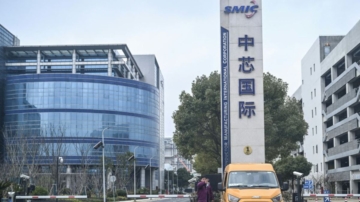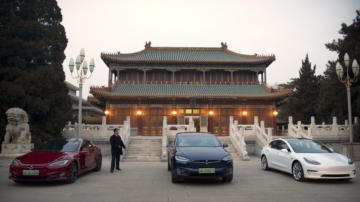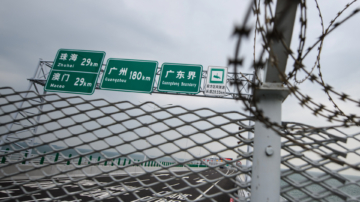【新唐人2011年9月22日訊】三年前爆發的全球金融海嘯,中國順利的躲過風暴,並在緊縮貨幣政策下,不少國企變身「影子銀行」。隨著貸款期限的到來,近期爆發了一連串的高利貸崩盤事件,外媒警告,中國版「次貸危機」即將上演。
2008年全球金融海嘯爆發後,中國開始實施緊縮政策,中小企借貸無門,不少國企成了資金的提供者,這些國企從官方銀行系統取得資金後,轉手再貸出,為企業注入了可觀的利息收益。除此之外,非官方影子銀行規模的擴大,也讓問題不斷暴露出來。經濟學家擔心中國恐爆發次貸危機。
上週在大連舉行的世界經濟論壇(World Economic Forum)上,原全國人民代表大會常務委員會副委員長的成思危語出驚人說,「中國版的美國次貸危機是把錢借給了沒有還款能力的地方政府。」
據估計,中國四大銀行多達80%的貸款是貸給了國有企業。而中國目前有多種形式的「影子銀行」,從國企、民間擔保機構到個人,多有官方背景。貸款成為了地方政府的投資方式,資金規模估計多達1.7萬億美元。
可怕的是,這些「影子銀行」都是不受監管或少受監管的非銀行金融機構。
經濟評論家草庵居士表示,一些國企擁有資金的優勢,透過一些平臺或擔保公司向外放貸,在缺乏信用體制下,這問題一旦爆發將會比美國次貸更加嚴重。
草庵居士:「現在經濟整個萎縮情況下,中國這些大量需要錢的中小型企業,這個錢借出去之後呢,很難有企業能夠有這個60%到100%利潤,這個講白了就是一個非常大的風險,這種情況尤其一些企業,他的想法是:我能借到錢度過難關我就能維持下去了,如果維持不下去我可以跑掉。」
中國新增貸款佔新增國內生產總值的比例,從雷曼兄弟倒閉前的不到100%增加到今天的200%左右。而不良貸款率也從2010年上半年的1%大幅上升到2011年上半年的 4.9%。
紐約(城市)市立大學經濟學教授陳志飛指出,很多專家分析,今年(2011年)是私人企業自改革開放以來最難過的一年,根據工商聯做的調查,90%的中國企業沒有拿到銀行的一分錢,95%的私人微型企業也拿不到銀行的貸款,這是國家資金分配不合理的現象。
陳志飛:「中國這種資金分配是國有的資金政策,它已經成型了十幾二十年,尤其在金融危機發生之後有四萬億的投入,就是說如果他的回報拿不到他的成本的話,我覺得這個危機造成很多銀行,會面臨壞帳,和國家整個經濟活動崩潰有這個危險。」
北京經濟學者茅於軾表示,中國四大銀行是國家管制的銀行,但還是發生了幾萬億的不良貸款。
茅於軾:「企業從銀行借了錢然後轉手去放高利貸,問題就是因為我們利息不是市場化,它是官僚化的,它是有特權的人可以借錢,一般人借不到,只能借高利貸,這問題就在這。」
茅於軾表示,要解決這個問題,就是開放中小銀行,讓老百姓辦銀行,不要國家壟斷。
新唐人記者梁欣、李庭、王明宇採訪報導。
China’s Subprime Mortgage Crash
The Global Financial Crisis (GFC) started three years ago,
but China seems to be immune to it.
Under the tightening monetary policy,
many of enterprises are turning into shadow banks.
With the due date of loan sharking approaching,
the economic claps occur continuously.
Foreign media warned that the Chinese version
of the Subprime Mortgage Crash is approaching.
After the start of the GFC in 2008,
China began changing its monetary policy.
For small and medium size firms its difficult
to access the formal banking sector.
Instead, they loan money from shadow lenders
who are actually state companies.
The official sector can obtain money from state-owned banks
and issue loans to other borrowers with higher interest rates.
In addition, non state-owned shadow banks are expanding,
and more problems are being exposed.
Economists are worried that China is starting to follow
the pattern of the U.S.’ Subprime Mortgage Crash.
During the World Economic Forum held in Dalian last week,
a former vice chairman of NPC, Cheng Siwei said:
"China’s Subprime Mortgage Crash is the lending of money
to local governments which have no ability to repay them."
It is estimated that 80% of the loans from the top four banks
in China go to state-owned firms.
But now China has different shadow banks, from state-owned
to individuals’ firm, most of them with officials’ background.
Local governments use state funds to invest in businesses,
and the funds are estimated to be ca. $1.7 trillion.
These shadow banks are outside the banking and financial
sectors and are thus less regulated or not regulated at all.
Economist Cao An thinks that the state-owned firms
have the advantage of funds.
They can lend the money through guarantee companies
or other platforms.
In this lack of credit system, once the problem is exposed,
it will be worse than what happened in the U.S.
Cao An: "The economic trend is at a low point,
small or medium-sized firms need plenty of funds.
But even with the loans it is difficult for them to make
60-100% profit and service the loan; this is a risk for lenders.
Therefore if the borrowers fail to service and repay the loans,
this will become a bad debt."
China added new loans, adjusted to its GDP. They went up
to 200%, from 100% prior to Lehman Brothers’ collapse.
Subsequently, the bad debt rate raised
from 1% in the first half of 2010 to 4.9% in 2011.
Chen Zhifei, Economy Professor, New York City University,
points out experts’ analysis,
which shows 2011 as the most difficult year for China
since China’s open market economy had started.
According to a survey done by the Industrial Federation,
90% of the firms in China don’t get a penny from the banks,
and 95% of the private firms don’t get loans from banks
either, showing that funds allocation is not sound.
Chen Zhifei: "China’s fund distribution is for state-owned
enterprises, This policy exists for 10 to 20 years now.
After the GFC started, China had loaned
RMB 4 trillion for investments.
If these investments’ loans do not get repaid, they will turn
into bad debts and the country’s economy will collapse."
Beijing economist Mao Yushi points out that although
the top four banks in China are controlled by the government, the accumulation of bad debts still occurs
Mao Yushi: "The companies borrow money from the banks
and lend them as high interest rate loans.
The problem is due to lack of interest rates’ market regulation.
It’s bureaucratic as it’s the privileged who can borrow money.
Most of the people can only borrow high interest rate loans,
this is the reason why the problem exists for so long."
Mao Yushi thinks that the solution to these problems
is to open small and medium-sized banks,
and let people establish such banks as well,
not only the government.
NTD reporters Liang Xi, Li Ting and Wang Mingyu.
2008年全球金融海嘯爆發後,中國開始實施緊縮政策,中小企借貸無門,不少國企成了資金的提供者,這些國企從官方銀行系統取得資金後,轉手再貸出,為企業注入了可觀的利息收益。除此之外,非官方影子銀行規模的擴大,也讓問題不斷暴露出來。經濟學家擔心中國恐爆發次貸危機。
上週在大連舉行的世界經濟論壇(World Economic Forum)上,原全國人民代表大會常務委員會副委員長的成思危語出驚人說,「中國版的美國次貸危機是把錢借給了沒有還款能力的地方政府。」
據估計,中國四大銀行多達80%的貸款是貸給了國有企業。而中國目前有多種形式的「影子銀行」,從國企、民間擔保機構到個人,多有官方背景。貸款成為了地方政府的投資方式,資金規模估計多達1.7萬億美元。
可怕的是,這些「影子銀行」都是不受監管或少受監管的非銀行金融機構。
經濟評論家草庵居士表示,一些國企擁有資金的優勢,透過一些平臺或擔保公司向外放貸,在缺乏信用體制下,這問題一旦爆發將會比美國次貸更加嚴重。
草庵居士:「現在經濟整個萎縮情況下,中國這些大量需要錢的中小型企業,這個錢借出去之後呢,很難有企業能夠有這個60%到100%利潤,這個講白了就是一個非常大的風險,這種情況尤其一些企業,他的想法是:我能借到錢度過難關我就能維持下去了,如果維持不下去我可以跑掉。」
中國新增貸款佔新增國內生產總值的比例,從雷曼兄弟倒閉前的不到100%增加到今天的200%左右。而不良貸款率也從2010年上半年的1%大幅上升到2011年上半年的 4.9%。
紐約(城市)市立大學經濟學教授陳志飛指出,很多專家分析,今年(2011年)是私人企業自改革開放以來最難過的一年,根據工商聯做的調查,90%的中國企業沒有拿到銀行的一分錢,95%的私人微型企業也拿不到銀行的貸款,這是國家資金分配不合理的現象。
陳志飛:「中國這種資金分配是國有的資金政策,它已經成型了十幾二十年,尤其在金融危機發生之後有四萬億的投入,就是說如果他的回報拿不到他的成本的話,我覺得這個危機造成很多銀行,會面臨壞帳,和國家整個經濟活動崩潰有這個危險。」
北京經濟學者茅於軾表示,中國四大銀行是國家管制的銀行,但還是發生了幾萬億的不良貸款。
茅於軾:「企業從銀行借了錢然後轉手去放高利貸,問題就是因為我們利息不是市場化,它是官僚化的,它是有特權的人可以借錢,一般人借不到,只能借高利貸,這問題就在這。」
茅於軾表示,要解決這個問題,就是開放中小銀行,讓老百姓辦銀行,不要國家壟斷。
新唐人記者梁欣、李庭、王明宇採訪報導。
China’s Subprime Mortgage Crash
The Global Financial Crisis (GFC) started three years ago,
but China seems to be immune to it.
Under the tightening monetary policy,
many of enterprises are turning into shadow banks.
With the due date of loan sharking approaching,
the economic claps occur continuously.
Foreign media warned that the Chinese version
of the Subprime Mortgage Crash is approaching.
After the start of the GFC in 2008,
China began changing its monetary policy.
For small and medium size firms its difficult
to access the formal banking sector.
Instead, they loan money from shadow lenders
who are actually state companies.
The official sector can obtain money from state-owned banks
and issue loans to other borrowers with higher interest rates.
In addition, non state-owned shadow banks are expanding,
and more problems are being exposed.
Economists are worried that China is starting to follow
the pattern of the U.S.’ Subprime Mortgage Crash.
During the World Economic Forum held in Dalian last week,
a former vice chairman of NPC, Cheng Siwei said:
"China’s Subprime Mortgage Crash is the lending of money
to local governments which have no ability to repay them."
It is estimated that 80% of the loans from the top four banks
in China go to state-owned firms.
But now China has different shadow banks, from state-owned
to individuals’ firm, most of them with officials’ background.
Local governments use state funds to invest in businesses,
and the funds are estimated to be ca. $1.7 trillion.
These shadow banks are outside the banking and financial
sectors and are thus less regulated or not regulated at all.
Economist Cao An thinks that the state-owned firms
have the advantage of funds.
They can lend the money through guarantee companies
or other platforms.
In this lack of credit system, once the problem is exposed,
it will be worse than what happened in the U.S.
Cao An: "The economic trend is at a low point,
small or medium-sized firms need plenty of funds.
But even with the loans it is difficult for them to make
60-100% profit and service the loan; this is a risk for lenders.
Therefore if the borrowers fail to service and repay the loans,
this will become a bad debt."
China added new loans, adjusted to its GDP. They went up
to 200%, from 100% prior to Lehman Brothers’ collapse.
Subsequently, the bad debt rate raised
from 1% in the first half of 2010 to 4.9% in 2011.
Chen Zhifei, Economy Professor, New York City University,
points out experts’ analysis,
which shows 2011 as the most difficult year for China
since China’s open market economy had started.
According to a survey done by the Industrial Federation,
90% of the firms in China don’t get a penny from the banks,
and 95% of the private firms don’t get loans from banks
either, showing that funds allocation is not sound.
Chen Zhifei: "China’s fund distribution is for state-owned
enterprises, This policy exists for 10 to 20 years now.
After the GFC started, China had loaned
RMB 4 trillion for investments.
If these investments’ loans do not get repaid, they will turn
into bad debts and the country’s economy will collapse."
Beijing economist Mao Yushi points out that although
the top four banks in China are controlled by the government, the accumulation of bad debts still occurs
Mao Yushi: "The companies borrow money from the banks
and lend them as high interest rate loans.
The problem is due to lack of interest rates’ market regulation.
It’s bureaucratic as it’s the privileged who can borrow money.
Most of the people can only borrow high interest rate loans,
this is the reason why the problem exists for so long."
Mao Yushi thinks that the solution to these problems
is to open small and medium-sized banks,
and let people establish such banks as well,
not only the government.
NTD reporters Liang Xi, Li Ting and Wang Mingyu.








